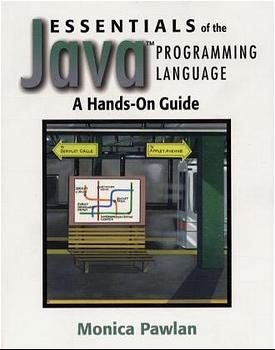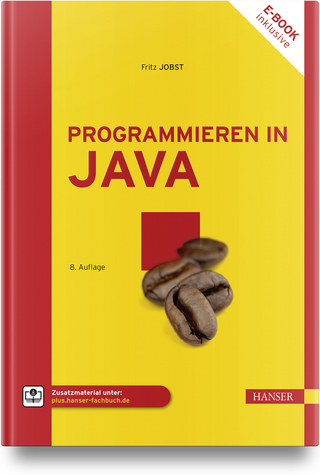
Essentials of the Java™ Programming Language
Addison Wesley (Verlag)
978-0-201-70720-5 (ISBN)
- Titel ist leider vergriffen;
keine Neuauflage - Artikel merken
If your students are interested in learning the Java(tm) programming language but hesitate to dive into overly dense, theoretical resources, Essentials of the Java(tm) Programming Language is the perfect starting point. This accessible, hands-on tutorial employs a "learn-by-doing" approach to introduce students to the basics. It starts with a simple program, then develops it bit by bit, adding new features and explaining important concepts with each subsequent lesson. This simple program grows into a general electronic commerce application that illustrates many of the Java 2 platform's most important elements.
Essentials of the Java(tm) Programming Language ends with an explanation of object-oriented programming concepts, made far more understandable and relevant as a result of the hands-on experience acquired throughout the book. After working through this book, you will have the foundation necessary to comfortably progress to more advanced learning materials for the Java programming language and utilize the subtleties and more sophisticated capabilities of the language.
Monica Pawlan is a staff writer for the Java Developer Connection (JDC), and was a contributing author for The Java™ Tutorial. She has a background in 2D and 3D graphics, security, and database products, and loves to study and write about emerging technologies. When not writing, she spends her spare time gardening, studying classical piano, and dreaming of far away places—some of which she occasionally visits. 0201707209AB03292002
Preface.
Acknowledgments.
LESSON 1.
Compiling and Running a Simple Program.
Covered in This Lesson.
A Word About the Java Platform.
Setting Up Your Computer.
Writing a Program.
Compiling the Program.
Interpreting and Running the Program.
Code Comments.
Double Slashes.
C-Style Comments.
Doc Comments.
API Documentation.
Setting the CLASSPATH Environment Variable on a Windows Platform.
Exercises.
More Information.
LESSON 2.
Building Applications.
Covered in This Lesson.
Application Structure and Elements.
Fields and Methods.
Constructors.
To Summarize.
Exercises.
More Information.
LESSON 3.
Building Applets.
Covered in This Lesson.
Application to Applet.
Run the Applet.
Applet Structure and Elements.
Extending a Class.
Behavior.
Appearance.
Packages.
Exercises.
More Information.
LESSON 4.
Building a User Interface.
Covered in This Lesson.
Project Swing APIs.
Import Statements.
Class Declaration.
Instance Variables.
Constructor.
Action Listening.
Event Handling.
Main Method.
Exercises: Applets Revisited.
Summary.
More Information.
LESSON 5.
Building Servlets.
Covered in This Lesson.
About the Example.
HTML Form.
Servlet Code.
Class and Method Declarations.
Method Implementation.
JavaServer Pages.
HTML Form.
JavaServer Page.
Exercises.
More Information.
LESSON 6.
File Access and Permissions.
Covered in This Lesson.
File Access by Applications.
Constructor and Instance Variable Changes.
Method Changes.
System Properties.
File.separatorChar.
Exception Handling.
File Access by Applets.
Granting Applets Permission.
Creating a Policy File.
Running an Applet with a Policy File.
Restricting Applications.
File Access by Servlets.
Exercises.
More Information.
Code for This Lesson.
FileIO Program.
FileIOAppl Program.
FileIOServlet Program.
AppendIO Program.
LESSON 7.
Database Access and Permissions.
Covered in This Lesson.
Database Setup.
Create Database Table.
Database Access by Applications.
Establishing a Database Connection.
Final and Private Variables.
Writing and Reading Data.
Database Access by Applets.
JDBC Driver.
JDBC-ODBC Bridge with ODBC Driver.
Database Access by Servlets.
Exercises.
More Information.
Code for This Lesson.
Dba Program.
DbaAppl Program.
DbaOdbAppl Program.
DbaServlet Program.
LESSON 8.
Remote Method Invocation.
Covered in This Lesson.
About the Example.
Program Behavior.
File Summary.
Compile the Example.
Start the RMI Registry.
Start the Server.
Run the RMIClient1 Program.
Run the RMIClient2 Program.
RemoteServer Class.
Send Interface.
RMIClient1 Class.
actionPerformed Method.
main Method.
RMIClient2 Class.
actionPerformed Method.
main Method.
Exercises.
More Information.
Code for This Lesson.
RMIClient1 Program.
RMIClient2 Program.
RemoteServer Program.
Send Interface.
LESSON 9.
Socket Communications.
Covered in This Lesson.
What are Sockets and Threads?
About the Examples.
Example 1: Client-Side Behavior.
Example 1: Server-Side Behavior.
Example 1: Compile and Run.
Example 1: Server-Side Program.
listenSocket Method.
actionPerformed Method.
Example 1: Client-Side Program.
listenSocket Method.
actionPerformed Method.
Example 2: Multithreaded Server Example.
Exercises.
More Information.
Code for This Lesson.
SocketClient Program.
SocketServer Program.
SocketThrdServer Program.
LESSON 10.
User Interfaces Revisited.
Covered in This Lesson.
About the Example.
Fruit Order Client (RMIClient1).
Server Program.
View Order Client (RMIClient2).
Compile and Run the Example.
Fruit Order (RMIClient1) Code.
Instance Variables.
Constructor.
Event Handling.
Cursor Focus.
Converting Strings to Numbers and Back.
Server Program Code.
Send Interface.
RemoteServer Class.
View Order Client (RMIClient2) Code.
Exercises.
Calculations and Pressing Return.
Non-Number Errors.
Extra Credit.
More Information.
Code for This Lesson.
RMIClient1 Program.
RMIClient2 Program.
RMIClient1 Improved Program.
LESSON 11.
Developing the Example.
Covered in This Lesson.
Tracking Orders.
sendOrder Method.
getOrder Method.
Other Changes to Server Code.
Maintaining and Displaying a Customer List.
About Collections.
Creating a Set.
Accessing Data in a Set.
Displaying Data in a Dialog Box.
Exercises.
More Information.
Code for This Lesson.
RemoteServer Program.
RMIClient2.
LESSON 12.
Internationalization.
Covered in This Lesson.
Identify Culturally Dependent Data.
Create Keyword and Value Pair Files.
German Translations.
French Translations.
Internationalize Application Text.
Instance Variables.
main Method.
Constructor.
actionPerformed Method.
Internationalize Numbers.
Compile and Run the Application.
Compile.
Start the RMI Registry.
Start the Server.
Start the RMIClient1 Program in German.
Start the RMIClient2 Program in French.
Exercises.
More Information.
Code for This Lesson.
RMIClient1.
RMIClient2.
LESSON 13.
Packages and JAR File Format.
Covered in This Lesson.
Setting up Class Packages.
Create the Directories.
Declare the Packages.
Make Classes and Fields Accessible.
Change Client Code to Find the Properties Files.
Compile and Run the Example.
Compile.
Start the RMI Registry.
Start the Server.
Start the RMIGermanApp Program.
Start the RMIClient2 Program in French.
Using JAR Files to Deploy.
Server Set of Files.
Fruit Order Set of Files (RMIClient1).
View Order Set of Files.
Exercises.
More Information.
LESSON 14.
Object-Oriented Programming.
Covered in This Lesson.
Object-Oriented Programming.
Classes.
Objects.
Well-Defined Boundaries and Cooperation.
Inheritance and Polymorphism.
Data Access Levels.
Classes.
Fields and Methods.
Global Variables and Methods.
Your Own Classes.
Well-Defined Boundaries and Cooperation.
Inheritance.
Access Levels.
Exercises.
More Information.
APPENDIX A.
Cryptography.
Covered in This Lesson.
About the Example.
Compiling and Running the Example.
Source Code.
Sealing the Symmetric Key.
Encrypting the Symmetric Key with the RSA Algorithm.
Exercises.
More Information.
APPENDIX B.
Code Listings.
Covered in This Lesson.
Application Code.
Application Code.
RMIClient1.
Application Code.
RMIClient2.
Application Code.
DataOrder.
Application Code:
Send.
Application Code.
RemoteServer.
Application Code.
RMIFrenchApp.
Application Code.
RMIGermanApp.
Application Code.
RMIEnglishApp.
Cryptography Example.
Sealing the Symmetric Key.
RMIClient1 Program.
Sealing the Symmetric Key.
RMIClient2 Program.
Encrypting the Symmetric Key with the RSA Algorithm.
RMIClient1 Program.
Encrypting the Symmetric Key with the RSA Algorithm.
RMIClient2 Program.
Index.
| Erscheint lt. Verlag | 17.5.2000 |
|---|---|
| Verlagsort | Boston |
| Sprache | englisch |
| Gewicht | 482 g |
| Themenwelt | Informatik ► Programmiersprachen / -werkzeuge ► Java |
| Mathematik / Informatik ► Informatik ► Web / Internet | |
| ISBN-10 | 0-201-70720-9 / 0201707209 |
| ISBN-13 | 978-0-201-70720-5 / 9780201707205 |
| Zustand | Neuware |
| Informationen gemäß Produktsicherheitsverordnung (GPSR) | |
| Haben Sie eine Frage zum Produkt? |
aus dem Bereich


